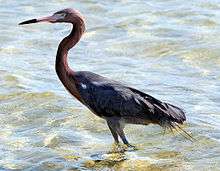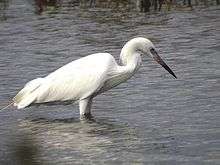Reddish egret
The reddish egret (Egretta rufescens) is a medium-sized heron. It is a resident breeder in Central America, The Bahamas, the Caribbean, the Gulf Coast of the United States, and Mexico.[2] There is post-breeding dispersal to well north of the nesting range. In the past, this bird was a victim of the plume trade.
| Reddish egret | |
|---|---|
 | |
| Scientific classification | |
| Kingdom: | Animalia |
| Phylum: | Chordata |
| Class: | Aves |
| Order: | Pelecaniformes |
| Family: | Ardeidae |
| Genus: | Egretta |
| Species: | E. rufescens |
| Binomial name | |
| Egretta rufescens (Gmelin, 1789) | |
According to the Texas Parks and Wildlife Department, there are only 1,500 to 2,000 nesting pairs of reddish egrets in the United States — and most of these are in Texas.[3] They are classified as "threatened" in Texas and receive special protection.
Description

This species reaches 68–82 cm (27–32 in) in length, with a 116–125 cm (46–49 in) wingspan.[3][4] Body mass in this species can range from 364–870 g (0.802–1.918 lb).[5] Among standard linear measurements, the wing chord is 29–34.3 cm (11.4–13.5 in), the tail is 8.8–13 cm (3.5–5.1 in), the bill is 7.3–9.2 cm (2.9–3.6 in) and the tarsus is 11.7–14.7 cm (4.6–5.8 in).[6] It is a medium-sized, long-legged, long-necked heron with a long pointed pinkish bill with a black tip. It is distinctly larger than other co-existing members of the genus Egretta, but smaller than the great blue heron and great egret. The legs and feet are bluish-black. While the sexes are similar, there are two distinct color morphs. The adult dark morph has a slate blue body and reddish head and neck with shaggy plumes. The adult white morph has entirely white body plumage. Young birds have a brown body, head, and neck. During mating, the male's plumage stands out in a ruff on its head, neck and back.
Behavior
The reddish egret is considered one of the most active herons, and is often seen on the move. It stalks its prey visually in shallow water far more actively than other herons and egrets, frequently running energetically and using the shadow of its wings to reduce glare on the water once it is in position to spear a fish; the result is a fascinating dance. Due to its bold, rapacious yet graceful feeding behavior, author Pete Dunne nicknamed the reddish egret "the Tyrannosaurus rex of the Flats".[7] It eats fish, frogs, crustaceans, and insects. The bird's usual cry is a low, guttural croak.
Reproduction
Reddish egrets' breeding habitat is tropical swamps. It nests in colonies, often with other herons, usually on platforms of sticks in trees or shrubs. These colonies are usually located on coastal islands. These birds have raucous courtship displays. They generally involve shaking of the head during the greeting ceremony, followed by chases and circle flights. They also involve raising of the neck, back and crest feathers, accompanied by bill clacking, similar to the tricolored heron.
Gallery
 Canopy hunting
Canopy hunting With great egret at Long Key State Park
With great egret at Long Key State Park
 Intermediate morph in Jacksonville, Florida
Intermediate morph in Jacksonville, Florida Fishing the mangroves, Lac Cai, Bonaire
Fishing the mangroves, Lac Cai, Bonaire.jpg) Canopy fishing, Lac Cai, Bonaire
Canopy fishing, Lac Cai, Bonaire Reddish Egret (Bolsa Chica Wetlands - Huntington Beach, CA)
Reddish Egret (Bolsa Chica Wetlands - Huntington Beach, CA)
References
- BirdLife International (2012). "Egretta rufescens". IUCN Red List of Threatened Species. 2012. Retrieved 26 November 2013.CS1 maint: ref=harv (link)
- "Reddish Egret". BirdLife Species Factsheets. BirdLife International. Retrieved 2009-07-29.
- "Reddish Egret (Egretta rufescens)". Texas Parks and Wildlife Department. Retrieved 2009-07-29.
- "Reddish Egret". World Association of Zoos and Aquariums. Archived from the original on 2018-05-08. Retrieved 2012-03-29.
- "Reddish Egret". All About Birds. Cornell Lab of Ornithology.
- Lowther, Peter E.; Paul, Richard T. (2002). Poole, A. (ed.). "Reddish Egret (Egretta rufescens)". The Birds of North America Online. Ithaca: Cornell Lab of Ornithology. doi:10.2173/bna.633.
- Dunne, Pete (2006). Pete Dunne's Essential Field Guide Companion: A Comprehensive Resource for Identifying North American Birds. Houghton Mifflin Harcourt. ISBN 0-618-23648-1.
- Field Guide to the Birds of North America (4th ed.). National Geographic. 2002. ISBN 9780792268772.
- Bull, John; Farrand Jr., John (April 1984). The Audubon Society Field Guide to North American Birds, Eastern Region. New York: Alfred A. Knopf. ISBN 0-394-41405-5.
- Stokes, Donald W.; Stokes, Lillian Q. (1996). Stokes' Field Guide to Birds: Eastern Region. New York: Little Brown and Company. ISBN 978-0316818094.
External links
| Wikimedia Commons has media related to Egretta rufescens. |
| Wikispecies has information related to Egretta rufescens |
- Egretta rufescens at Field Guide: Birds of the World on Flickr
- "Reddish egret media". Internet Bird Collection.
- Reddish egret photo gallery at VIREO (Drexel University)
- Interactive range map of Egretta rufescens at IUCN Red List maps
- Audio recordings of Reddish egret on Xeno-canto.
